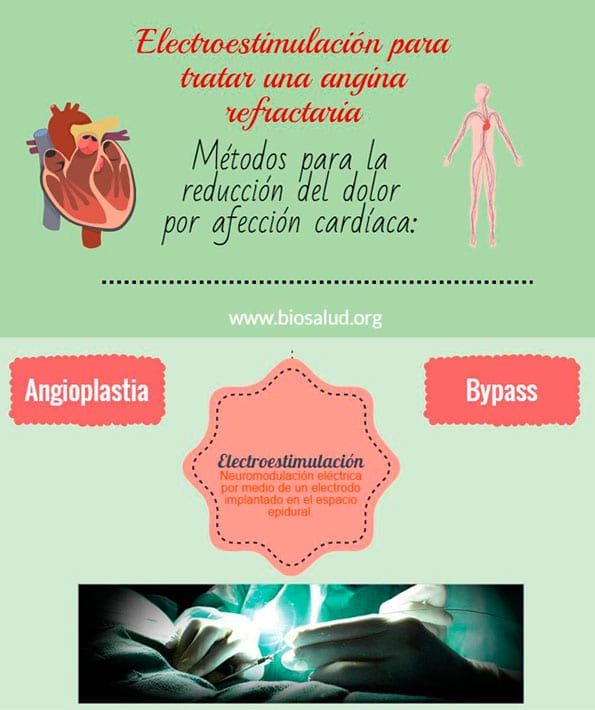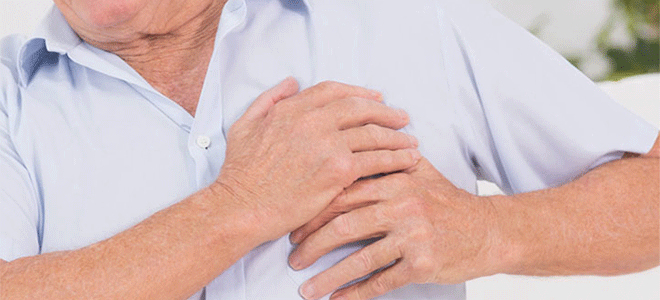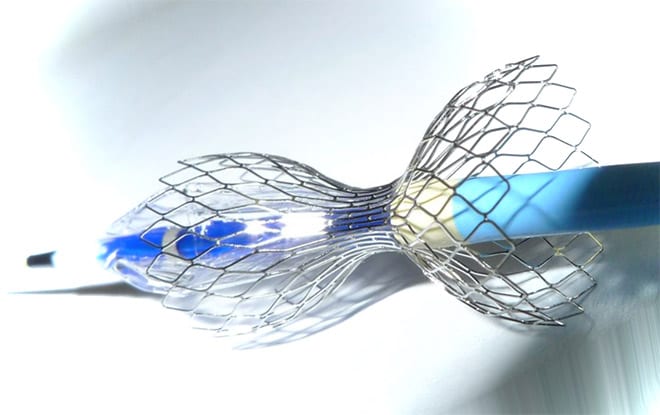
Methods of pain reduction for cardiac conditions
The angina pectoris is caused by the partial blockage of the coronary arteries due to the deposition of cholesterol plaques on the inside of the arteries, a phenomenon known as atherosclerosis.
Angina pectoris manifests itself as a chest pressure or painusually on the left side, which occurs regularly with physical activity or after heavy meals.

Symptoms can usually be treated with lifestyle changes, medications or procedures that open narrowed arteries and improve blood flow.
Refractory angina pectoris is a chronic disease characterised by the presence of angina caused by coronary insufficiency in the presence of coronary artery disease that cannot be controlled by a combination of medical therapy, angioplasty and coronary bypass surgery. The presence of reversible myocardial ischaemia must be surgically established as the cause of symptoms. Chronic ischaemia is defined as lasting more than 3 months.
It is about severe chest paincaused by coronary artery disease that cannot be relieved by coronary intervention, coronary artery bypass surgery, and coronary artery bypass surgery. medical treatment optimal.
Angina is a symptom and a symptom is a feeling that something is going on in the body. One of the problems for angina sufferers is that the internal organs (such as the heart, lungs, intestines and kidneys) are not very efficient at communicating to the brain what is happening.
To improve blood flow, the following common surgical procedures are available
- Balloon angioplasty and stenting. Angioplasty " also called percutaneous coronary intervention (PCI) " is a method by which the physician threads a deflated balloon in a catheter from the femoral artery or the radial inguinal artery through the blood vessels until they reach the site of the blockage in the heart. At the blockage, the balloon is inflated to open the artery, allowing blood to flow. A stent is often placed at the blockage site to permanently open the artery.
- Coronary artery bypass surgery. During this procedure, arteries or veins from another part of the patient's body are grafted into the coronary arteries to prevent narrowing from atherosclerosis, allowing blood to flow around the clogged or narrowed coronary artery. Because this requires open-heart surgery, it is reserved for cases of multiple coronary artery narrowing.
Electrical Neuromodulation or Electrostimulation
Some patients with chronic refractory angina pectoris are not candidates for surgical or percutaneous revascularisation and despite receiving optimal medical management, still experience severe angina episodes. In these cases, the electrostimulation. The spinal electrical stimulator is a neuromodulator that is used as a management alternative in these patients.
Spinal cord stimulation is a minimally invasive and reversible technique that uses the spinal cord to stimulate the spinal cord. electrical neuromodulation by means of an electrode implanted in the epidural space. It appears to be an effective and safe treatment for refractory angina pectoris.

Since the development of coronary revascularisation and the administration of drugs has resulted in an improved survival rate following a coronary event, it seems likely that the number of patients who remain severely disabled due to refractory angina will increase.
Today, most patients with coronary artery disease can be adequately treated with revascularisation and anti-anginal drugs. However, some patients are still reluctant to these treatments, or are not good candidates for percutaneous intervention, surgical revascularisation or additional procedures.. Some patients with significant intermittent angina demonstrate normal coronary arteries on angiography. The latter condition is known as "microvascular angina" or "cardiac syndrome X", and is characterised by typical chest pain with ST-segment depression on the exercise electrocardiogram.
The treatment options that have emerged for refractory angina include:
- thoracic epidural injection
- the cervico-thoracic ganglion block,
- improved external counterpulsation
- percutaneous myocardial laser revascularisation
- transcutaneous electrical nerve stimulation, and stimulation of the spinal cord (SCS).
Neuromodulation, and the SCS, can be defined as the electrical or chemical modification of the nervous system that changes the actual or perceived neurotransmission and response to a stimulus or disease. SCS is a minimally invasive technique in which electrodes are implanted in the epidural space to stimulate the dorsal columns of the spinal cord through the passage of an electrical current.
Since the first report of SCS as a treatment for angina pectoris was published in 1987, a large number of subsequent clinical trials and systematic reviews have demonstrated the clinical efficacy of SCS in angina pectoris in producing an anti-ischaemic effect, symptomatic relief, and improvements in functional status and quality of life.
A recent meta-analysis revealed similar outcomes and lower healthcare costs with SCS compared to percutaneous coronary artery bypass surgery and laser myocardial revascularisation for the treatment of refractory angina.
Potential explanations for the anti-anginal and anti-ischaemic effects of SCS include direct pain blockade, reduced oxygen consumption, decreased sympathetic tone, redistribution of myocardial blood flow from non-ischaemic to ischaemic areas, possible enhanced coronary microcirculatory blood flow, possible increased beta-endorphin levels and modulation of intracardiac neurons. However, SCS remains underutilised, possibly due to its only partially understood mechanism of action, as well as the rapid development of transluminal revascularisation procedures. The reluctance to employ SCS for refractory angina may also be due to the fear that this technique only treats pain without affecting ischaemia, thus masking acute myocardial infarction. However, it has been reported that SCS does not mask the pain of myocardial ischaemia as a warning sign for infarction.
In conclusion, patients with refractory angina pectoris suffer from severe symptoms and impaired activities of daily living. Spinal cord stimulation could allow them to have a reduction of pain and a better quality of life.
Implanted device could improve treatment of refractory angina
In early February 2015 a small study conducted by Dr. Shmuel Banai, and his interventional cardiology team at the Tel Aviv Sourasky Medical Center in Israel, shows that device called Receptor brings relief to people with refractory angina.

The device his team studied, called the Reducer, is already approved in Europe, but not yet in the United States. It is similar to a stent, a device that doctors commonly implant to prop clogged heart arteries open. But the reducer has an hourglass shape, and instead of being placed in an artery, it is implanted in a large vein in the heart, to alter the flow of blood out of the heart.
This helps keep more oxygen-rich blood circulating to the parts of the heart muscle that need it.
For now, though, the best thing most people can do is to take steps to prevent angina, or keep it from getting worse. That includes not smoking, eating a healthy diet, and keeping blood pressure and cholesterol down - with medication, if necessary.


1 thought on “Electroestimulación para tratar una angina refractaria”
Good afternoon, would your centre be equipped with the improved external counterpulsation for the treatment of stable angina pectoris? Thank you in advance and best regards.
Comments are closed.